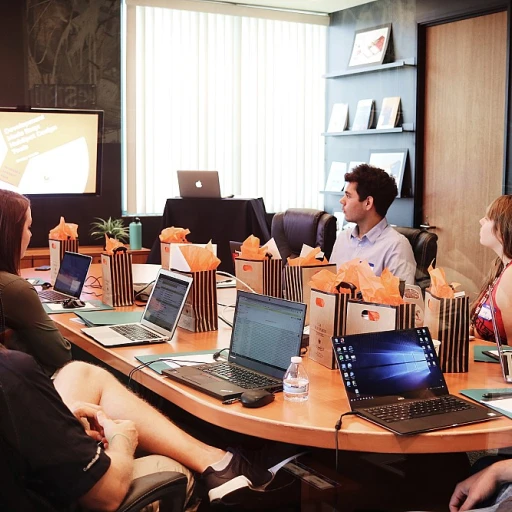
Understanding the Importance of a Strong Workplace Profile
Why a Strong Workplace Profile Matters
The concept of a "workplace profile" has evolved into a critical component in contemporary business strategies. In today's competitive job market, a strong workplace profile can make the difference between attracting top talent and losing them to competitors. This includes showcasing the unique aspects of a company's culture, values, and the benefits of being part of its team. Companies are realizing the importance of investing in their workplace profile not only to attract potential employees but also to retain their existing staff.
Effective employer branding goes beyond the simple dissemination of information. It's about creating an environment where employees are proud to contribute to a cohesive team, a place where they find value and meaning in their work. Elements such as leadership styles, emotional intelligence, and communication behaviors are crucial in forming a workplace profile that resonates with current and prospective employees alike. These components influence how your workplace is perceived both internally and externally.
Moreover, utilizing tools like DISC assessments, workplace DISC profiles, and profile reports can provide companies with deeper insights into employee behaviors and communication styles. These assessments help in understanding how various individuals interact within the group, promoting an atmosphere of effective collaboration. They aid in recognizing the strengths within the team and offer invaluable guidance for leadership training and facilitation. As a benefit, companies gain a more cohesive and productive workforce.
On the flip side, a weak workplace profile can lead to increased turnover, low morale, and difficulty in talent acquisition. Thus, enhancing and understanding your workplace profile is not just beneficial but necessary in today's dynamic business environment. Learn more about evolving strategies with our insights on the evolving role of job references in employer branding.
Current Trends in Employer Branding
What’s Shaping the Landscape of Employer Branding Today?
The world of employer branding is continuously transforming, driven by the constant need for organizations to attract, engage, and retain top talent. In recent years, several key trends have emerged, significantly influencing how companies present themselves as desirable employers. As businesses strive to create an inclusive and equitable work environment, understanding these trends becomes crucial.
Embracing Inclusivity and Diversity
Employers are placing a greater emphasis on building inclusive teams that reflect a wide range of backgrounds and perspectives. This commitment to diversity goes beyond the basic metrics and aims to create a truly inclusive environment where every employee feels valued and heard. Such environments foster better decision-making and problem-solving, providing a competitive edge in today’s diverse market landscape.
Enhancing Employee Well-Being
The pandemic has heightened awareness around the importance of employee well-being, shifting the focus to mental health and work-life balance. Organizations are implementing strategies and support systems to ensure their teams feel supported. The emergence of initiatives like mental health days, flexible working hours, and well-being programs are clear indicators of this trend.
Utilizing Technology for Improved Communication
Technology plays a pivotal role in shaping employer branding strategies. From digital assessments like DISC profiles and emotional intelligence tests to robust communication services, technology enhances interaction and engagement. Innovative platforms provide insightful group reports and feedback, helping teams and leaders align their work styles and behaviors for a more cohesive work environment.
Prioritizing Transparency and Authenticity
Today's workforce values transparency and authenticity. Open communication about policies, decisions, and even challenges can build trust and enhance a workplace profile. Employees are more engaged when they have clear insights into the organization's goals and leadership decisions, resulting in a cohesive team that shares a common vision.
Emphasis on Continuous Learning and Development
Many organizations are emphasizing continuous learning and leadership training as part of their employer branding strategy. Certifications like DISC management and facilitation courses empower leaders and employees alike, fostering a culture of growth and knowledge sharing. Such initiatives not only enhance the workplace profile but also contribute to personal and professional development.
Building an Authentic Workplace Culture
Fostering a Genuine Work Environment
Establishing an authentic workplace culture is no small feat, but when done successfully, it can significantly bolster your workplace profile. Organizations are increasingly recognizing the value of nurturing a culture that aligns with their core values and mission. This alignment not only improves employee satisfaction but also attracts like-minded talent. One critical aspect is the focus on developing a cohesive team environment. This involves understanding the different behavioral styles present within the organization. Utilizing tools like the DISC assessment and PXT Select can aid in identifying DISC profiles, enabling the alignment of tasks with individuals' strengths. DISC certification and training programs can further assist leaders in enhancing effective communication, adapting their leadership styles to various team dynamics. Leaders play a pivotal role in shaping and maintaining such a culture. Through continuous leadership training and development, they learn to model the behaviors that drive cohesion. Services designed to facilitate leadership growth can impact enormously, as leaders with high emotional intelligence and adaptability are better equipped to foster an inclusive and motivating environment. It's also pertinent to consider the role of emotional intelligence in the workplace. Emotional intelligence drives more empathetic interactions and the ability to manage varied DISC styles effectively. Regular group and profile reports can help track progress and identify areas needing attention, ensuring a proactive approach to workplace harmony. As you navigate the evolving landscape of employer branding, consider leveraging the next-gen talent management systems that provide deeper insights into employee engagement trends and culturally cohesive behaviors. Such innovations can provide the scaffolding needed to build an authentic and attractive organizational identity.Leveraging Technology for Employer Branding
Integrating Technology to Elevate Your Employer Brand
In today's digitized world, leveraging technology in employer branding is not just a trend, but a necessity. It helps shape a comprehensive understanding of your workplace profile and elevates the overall perception among potential employees. Integrating modern tools can significantly enhance how employees and stakeholders view your workplace. Utilizing DISC Workplace Profiles Technology allows us to access valuable insights quickly. One effective technique is implementing DISC assessments and profiles. DISC management provides profound insights into work styles and behaviors, which helps in nurturing a more cohesive team. By using DISC workplace profiles, employers can tailor communication and leadership strategies to fit diverse team styles.Advanced Tools for Enhanced Insights
Employing tools like the PXTS Select assessment can help refine the recruitment process, creating a more efficient method for identifying compatible candidates. With options to generate a detailed workplace profile report or group report, leaders can make informed decisions that align with workplace culture.Training and Certification
Embracing technology involves constant learning. Disc certification and training services offer leadership and team members the necessary facilitation skills to understand DISC styles. With proper training, companies can enhance emotional intelligence among their ranks, leading to more effective communication and improved work dynamics. Organizations that focus on disc style assessments and invest in disc certifications empower their teams with insights for improved collaboration. Training that emphasizes leaders' understanding of DISC profiles can also forge an environment ripe for innovation and productivity. Overall, technology is a facilitator that helps us learn and grow. By integrating tech-efficient assessment tools and providing comprehensive training, companies can build a workplace culture that not only appeals to potential employees but also retains and nurtures existing talent.Measuring the Impact of Your Employer Branding Efforts
Evaluating Your Investment in Branding Efforts
It's crucial for organizations to take stock of their employer branding strategies periodically to assess how well they are resonating with their target audience and contributing to a cohesive team environment. Measuring the impact of these efforts involves a multi-faceted approach, ensuring a holistic view of the organization's workplace profile and the team dynamics.
Utilizing DISC Assessments and Profiles
One effective tool to aid this evaluation is the DISC assessment. This tool helps in analyzing the behaviors of team members, offering insights into their communication styles and how these contribute to the overall workplace environment. DISC profiles can pinpoint the cohesiveness of the team and highlight areas where cohesion might be improved via targeted training or team-building exercises.
Regularly reviewing these assessment reports can provide valuable feedback about emotional intelligence levels and leadership facilitation opportunities within the group. Teams who have undergone DISC certification and training can often communicate more effectively, as there is a shared understanding of each other's DISC styles.
Gathering Data through Employee Feedback
Alongside DISC assessments, actively soliciting feedback from employees is another way to gauge the impact of your branding efforts. Surveys and group report sessions can unearth insights into which aspects of the workplace culture are resonating positively and which ones may require attention or restructuring.
Benchmarking and Analyzing Performance Metrics
Your company’s work profile should be regularly benchmarked against industry standards, using tools like PXT Select, to track improvements in areas pertinent to the organization’s goals. These metrics might include talent retention rates, employer attractiveness, and the cost-effectiveness of recruitment services. A thorough analysis of this data can reveal the efficacy of your employer branding initiatives.
Creating a Consistent Review Schedule
Establishing a routine schedule for reviewing DISC profiles, cohort performance, and employee feedback ensures that your branding strategies remain agile and impactful. Regular meetings with leadership teams to discuss these findings can lead to a more dynamic and adaptive workplace culture. Consistency in assessment and adjustment is key to maintaining an attractive and effective workplace branding strategy.













